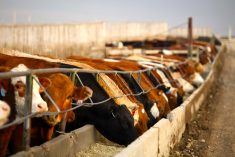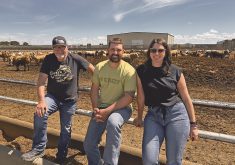Properly constructed facilities and appropriate cattle-handling equipment confine cattle safely and efficiently with minimal stress and risk of injury to cattle and workers, going a long way to help alleviate much of the stress and frustration staff experience when working with excited, stubborn or aggressive animals.
Auditors award five points if facilities and equipment are adequate to safely handle, restrain, treat, segregate and (un)load cattle, and wide enough to accommodate bloated animals, with a side-release gate for assisting calving heifers. Two points are given for having a safe, clean environment available for new cow-calf pairs.
Read Also

Body condition, nutrition and vaccination for brood cows
One of the remarkable events of the past century related to ranching has been the genetic evolution of brood cows….
Special attention is paid to gates and non-slip footing: each rates five points. Gates must swing freely and latch securely, with no sharp protrusions. Examples of non-slip surfaces in alleyways and handling areas include sand, straw, wood shavings, rubber mats and grooved concrete flooring. Stairs or cleating are recommended for ramps along with a level dock before going up or down ramps to prevent slipping. The ground and ramps must also be free of holes, rocks, ice, and excessive rough, frozen manure that could cause an animal to trip.
Lighting is assessed in cattle handling and (un)loading areas. Animals tend to move better from dim to more brightly lit areas than vice versa, so lighting in the chute area should be brighter than in the alley but not shining directly into the eyes of approaching animals. If the entire working area is lit, lights should be placed to provide uniform illumination.
Indoor lighting and air quality are additional considerations worth five points each for feedlot pens in barns. Lighting is considered to be adequate if the auditor is able to see well enough to assess the environment and animals’ health. If the auditor smells ammonia, or experiences headache, nausea, burning eyes, nose, throat or skin, then the ammonia level is scored as being above the minimum acceptable level of 25 parts per million.
Overall protection from heat and cold for indoor and outdoor pen areas is worth five points. Windbreak fencing and straw bedding packs are examples of adequate outdoor protection. A documented pen maintenance plan or records of how mud and manure buildup is minimized is worth two points.
Providing low-stress handling training for employees who work with cattle is worth five points, and records of training activities count for two more points. Low-stress handling generally refers to calm, quiet handling techniques using cattle’s natural flight zones, with minimal use of prods and proper use of appropriate handling equipment including chutes and handling tools.
Acceptable cattle-handling tools include plastic rattle paddles, sticks with nylon flags, plastic streamers or garbage bags, stock sticks or vibrating prods without electrical stimulus. Electric prods are only acceptable when other acceptable handling tools have failed and then only if they are used properly on the animal (not on the head, genitalia or anus). They must be 50 volts or less and not wired directly to a power source.
Cattle-handling tools must not be used unnecessarily, aggressively or repeatedly on one animal or when an animal has nowhere to go.
A written protocol on handling non-ambulatory and severely injured animals counts for two points, as does your employees’ understanding the protocol.
Practical cattle handling is assessed for at least one hour or 100 head of cattle as they are moved through the crowding tub and alley leading to the chute and squeeze chute. Animals are scored only during active handling and only once for each action. Each of the eight categories is worth 10 points if the target is met:
- Falls — body touches floor; target ≤1%.
- Slips — knee or hock touches floor; target ≤5%.
- Electric prod use — touching an animal with a prod, regardless of whether electrical current is discharged; target ≤10%.
- Prod misuse — use of an electric prod as the first choice, when the animal has nowhere to go, or repeatedly and excessively; target 0%.
- Jumping — any time an animal stands on two feet; ≤5%.
- Racing — exiting the chute at a speed equivalent to the animal running full speed down an alleyway; ≤5%.
- Vocalization — audible during active handling or in the chute due to restraint, not due to a procedure such as implanting, tagging or injecting; target ≤15%.
- Mis-caught — restrained in the chute in any position other than with its head fully outside of the chute head bars and its body from the shoulders back within the chute, or if an animal behind the animal in the chute is caught in the tail/back gate and not released immediately; target 0%.
This is part of a series of articles on the new Canadian Feedlot Animal Care Assessment Program. Please see Canadian Cattlemen, May 2016, for more background. For more information, contact your provincial cattle feeder association for the link to all program documents on the National Cattle Feeders Association’s website or contact the NCFA, 403-769-1519, [email protected].

















